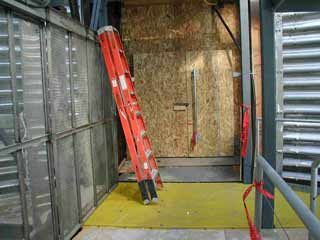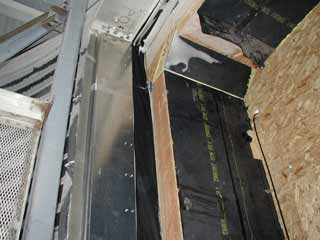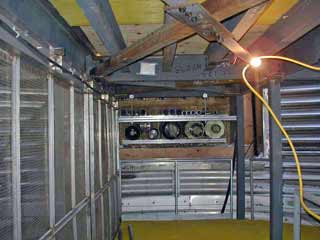2001-02 Photos - Inside A1, A2 and the vertical tower
(otherwise known as the beer can)
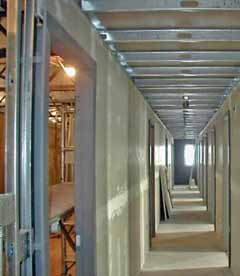 Here's a look down the berthing hallway on the second floor of A1, as of 10 November. The plan at this point was to get this finished and have about 20 wo's live here during the 2002 winter (photo by Andy Martinez). Here's a look down the berthing hallway on the second floor of A1, as of 10 November. The plan at this point was to get this finished and have about 20 wo's live here during the 2002 winter (photo by Andy Martinez). |
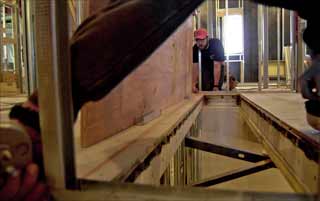 Carpenter Bruce Richardson (and someone with unidentified legs) are working on the second floor berthing on 11 November 2001. Photo by Melanie Conner, USAP Antarctic Photo Library. |
|
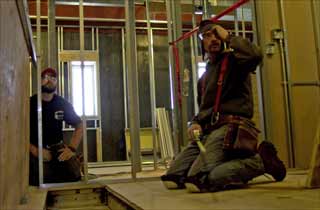 Another view of Bruce (at left) and another unidentified carp (help me out folks!) working in A1. Photo by Melanie Conner, USAP Antarctic Photo Library |
 Many of us have enjoyed a coffee break in the galley...but this year it was an unfinished shell, and a break area for the construction folks (11 November photo by Melanie Conner, USAP Antarctic Photo Library). |
|
|
So here's what was happening. The plan at the beginning of the 2001-02 summer was still to have about 20 people live on level 2 of the new station for the 2002 winter...and folks were working hard toward that end...finishing out that A1 berthing wing and putting together the mechanical and electrical equipment in A2 and the piping and electrical between the elevated station and the power plant. At this point there was almost no work going on in the new galley, as that wasn't a priority. I watched the progress from a distance and remained optimistic, but as I later watched berthing wing A4 get transformed from an empty shell into finished rooms (during my 2005 winter) I continue to be amazed at the amount of work involved. But as it turned out, there were other issues. These included late material delivery, problems with the sprinkler system design, and what turned out to be the deal killer--the settlement of the elevated station. | ||
| On 1 December 2001, Andy Martinez explained the issue. We're on the level 1 stair landing from the beer can into the elevated station (right). Note that the ramp toward the station is sloping down, meaning that the freezer doors will hit the ramp and not open fully. | ||
| Needless to say, the level 2 doors had the same issue, as seen at right. | Here's a closeup look at the upper left corner of the juncture between the beer can and the elevated station... note the stress in the black expansion joint, which was stretched to the max when this photo was taken. This illustrated that the elevated station was settling more than the beer can. | |
|
The problem was not merely the station doors--it was really the differential settlement between the vertical tower and the elevated station. The natural snow supporting the vertical tower was about 30 feet below the unprocessed natural snow supporting the elevated station, and the vertical tower was experiencing almost no settlement, while A1/A2 had settled about six inches since they'd been erected in 2000-01. And significant additional settlement was expected. 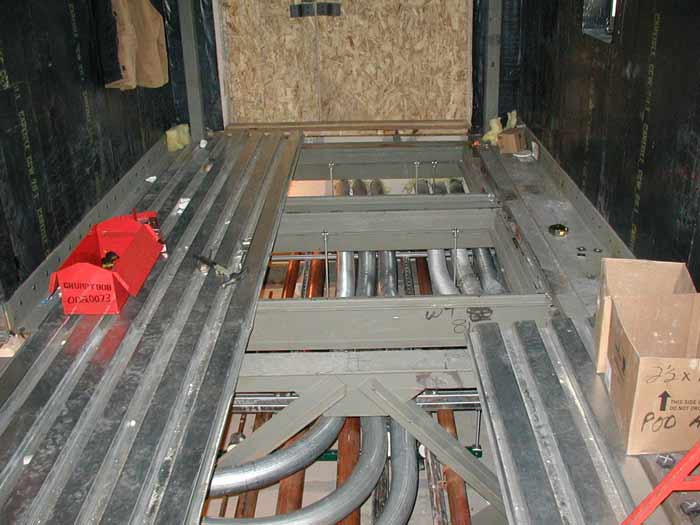 Here's an illustration of part of the issue...we are looking into the subfloor of the level 1 vestibule into the beer can, and all of the piping and conduits in there. It looks pretty tight even before any of the piping was insulated, and I've peered into that space (with difficulty, from the A2 subfloor), and I can attest that it is REALLY tight now. This photo is undated; presumably it is from early in the 2001-02 summer. | ||
|
So, what to do? Resolving this problem would involve modifying the structural relationships between the vertical tower stairs, the piping/electrical support system, and the vertical tower itself. As well as an attempt to determine the reason why the actual observed station settlement was more than what had been predicted. Not an easy problem...the short term answer was that efforts to complete A1 level 2 for occupancy for the 2002 winter had to be abandoned. As a temporary remedy, the stair tower structure was lowered a few inches by removing shims at the bottom. It would take the design team, along with NSF and RPSC, most of the 2002 winter to determine what to do, figure out how to do it, and order materials. The resolution eventually turned out to be a lowering of the beer can stair tower...which wasn't simple. It would require modifications to the structural relationships between the vertical tower stair structure, the structural support system for the piping and electrical, the elevator structure, and the openings and the flexible boot between the beer can and the station. The flexible piping and conduit connections had to be redesigned as well, and allowances had to be made for further adjustments in the future. All that wouldn't happen until the 2002-03 summer, and I WILL cover that elsewhere.
|
||
|
Unless noted otherwise, the photos on this page are from the Title II construction documentation...and most if not all of these are by Andy Martinez. And thanks for a bit of help from BK Grant for identifying Jason! Meanwhile...downwind of the station, the Rodwell 2 building was constructed. | ||
